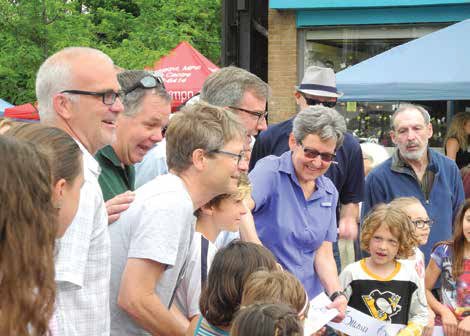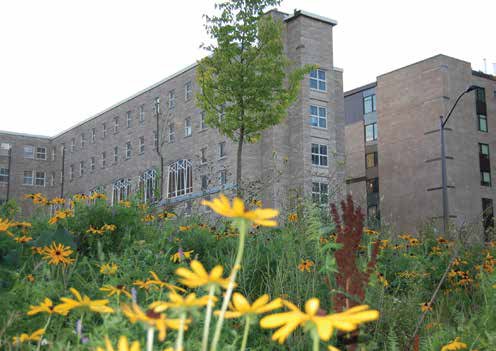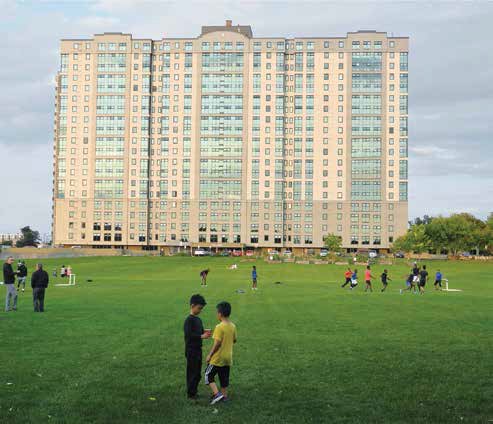Our local governments aren’t listening to our views on
many major Old Ottawa East project initiatives
In Part 1 of his report, Dance introduced the “Gunning Principles,” a framework of principles designed to assess the degree and effectiveness of public consultation afforded by our local decision-making authorities in connection with major initiatives in and around Old Ottawa East. According to the Gunning Principles, public consultation by our levels of local government tends to be meaningful and legitimate only when:
1. Proposals are still at a formative stage (that is when the decision has not already been made and the so-called consultation is simply an opportunity for the proponent
to say they shared information and sought input);
2. There is sufficient information to give “intelligent consideration.” The information provided must relate to the consultation and must be available, accessible, and easily
interpretable for consultees to provide an informed response;
3. There is adequate time for those consulted to consider and respond; and
4. “Conscientious consideration” must be given to the consultation responses before a decision is made.
In addition to these principles, successful community consultation depends on a variety of other factors including the capacity of those consulted to assess and respond;
the context for the consultation; and the inclusiveness of who is able to participate.
In the second and final part of his series, Dance reviews seven more recent or ongoing OOE initiatives and reports on whether and to what extent our local governments
and decision-making authorities are allowing Old Ottawa East citizens a meaningful opportunity to exercise their democratic rights to influence outcomes on major
community-changing projects.
John Dance
1. Greenfield, Main, Hawthorne (GMH) Reconstruction
Like the initial phase of Main Street reconstruction, this ongoing project is driven by the need to replace deteriorated underground services and replace combined sewer with separate storm and sanitary pipes. But it also provides, as former Councillor David Chernushenko used to say, a “once in a lifetime” opportunity to make major improvements to the roadway and pedestrian and cycling facilities.
Consultation for the GMH project was substantially affected by the pandemic, as consultation sessions had to become virtual. The “public information sessions” and the public advisory committee meetings were of a different nature than what was experienced for the first Main Street project. Fewer people were involved, fewer meetings were held, and discussions were primarily by email. The City of Ottawa’s shifting of its consultation model to a much more on-line approach seems, so far, to be inferior to the in-person “town hall” form of public consultation that had dominated before COVID.
The interventions of Councillor Shawn Menard assisted considerably to ensure that a number of improvements were made to the initial plans. Most notably, unlike in the previous project, the electrical cables are being buried on the major streets. Secondly, a new safe pedestrian crossing at the Main Street-Colonel By Drive intersection has already been built. And numerous improvements have been made to the initial plans to provide for greater pedestrian and cyclist safety. However, efforts to save more trees or at least have more trees planted to replace those that are removed to facilitate construction have not been successful.
The Gunning principles have generally been satisfied regarding public consultation on this project. However, partly because of the pandemic, there has been substantially less engagement of residents than there was with the first Main Street project.
Public Consultation grade: B
2. Alta Vista Transportation Corridor
No other initiative affecting Old Ottawa East (OOE) has taken so much advocacy effort on the part of residents. For decades, OOE, neighbouring communities and other parties have fought against the proposal to build a four-lane roadway running north from the intersection of Conroy and Walkley roads all the way to westbound Highway 417, and Nicholas Street. From Conroy and Walkley, the proposed Alta Vista Transportation Corridor (AVTC) route would knife through reserved lands going around the Ottawa Hospital, then over the Rideau River, across the People’s Park greenspace just to the east of Springhurst Park, and finally meeting Lees Avenue before connecting to Highway 417.
A short stretch of the roadway – the Hospital Link – has already been built at a cost of $62 million. While then-Mayor Jim Watson pledged not to build any other parts of the roadway, it’s still under consideration in the new transportation master plan development and it was included in the new Official Plan as a “future arterial.” Also, many people predicted that the construction of the Hospital Link would – pardon the pun – pave the way for constructing the rest of the roadway.
As Councillor Shawn Menard has said, “It’s an antiquated scheme to funnel vehicles from outlying areas to the core. In the decades since, the City has evolved. We have declared a climate emergency. We understand the value of 15-minute neighbourhoods. And we are investing heavily in transit and intensification downtown.”
Through environmental assessment work that has been done on the AVTC, residents have had opportunities to comment on proposals and they also have appeared at numerous City committee hearings to fight against the project. While they have been successful so far, in that funding has yet to be approved, there remain many parties who want AVTC built to provide a new north-south road to the City core.
The consultation on AVTC certainly has provided “adequate time to consider and respond,” but the City has failed to give “conscientious consideration” to the consultation responses before decisions are made. The case against AVTC has been greatly strengthened because of the climate emergency, the focus on 15-minute communities, the new LRT system and the increased need for greenspace in the core. Its removal from the transportation master plan should be a no-brainer.
Public Consultation grade: D
3. Immaculata High School Playing Field
In 2018, the Ottawa Catholic School Board (OCSB) leased the Immaculata High School playing field to Footy Sevens, a private soccer enterprise. The school board viewed the arrangement as a means of acquiring a more usable field for Immaculata students. However, the OCSB gave no consideration to the impact that the after-schoolhours use of the field would have on adjacent property owners or on the community.
The field certainly became more usable for the school because Footy Sevens rebuilt it with artificial turf, new drainage and a surrounding fence. However, the negative consequences for the neighbouring community included noise from referee whistles, yelling from spectators, players, and coaching staff until 11PM; light pollution; strong, long-term, odour from the artificial turf; and removal of a natural greenspace from the public realm where the public could play for free when school was out.
Despite opposition from the Old Ottawa East community and City of Ottawa staff’s attempt to impose reductions to the hours of the field’s use, the school board was unwavering and unresponsive, offering only an “information session” on the new arrangement that was held months after the private contract was signed.
In no way did consultation on this project satisfy any of the Gunning principles and, indeed, the OCSB gave no indication that they had any reason to discuss – let alone modify – the deal with Footy Sevens.
Public Consultation grade: F

4. Main Street Reconstruction – First Phase
Community organizations and residents from Old Ottawa East (OOE) and neighbouring communities were heavily involved over the three years of City of Ottawa planning for the reconstruction of Main Street and the refurbishment of the Smyth Road Bridge. A total of 20 working group meetings were held. The OOE Community Association (OOECA) had five members on the working group, and businesses, schools, churches, cycling and pedestrian advocacy groups and representatives of neighbouring communities regularly participated.
In addition, a series of open houses were held so that all residents could see what was being proposed and how it might affect them. Indeed, one open house was held at the Greenboro Community Centre so that commuters in the southern part of the City could provide their opinions on the various options for re-constructing Main Street.
Public consultation on this project readily satisfied all four Gunning Principles. Although several of the changes OOECA argued for were not accommodated (e.g., burying the electrical cables), a number of changes exceeded initial expectations. For instance, the Brantwood Gates were totally rebuilt and repositioned. Also, the cycle tracks and wider sidewalks turned out to be superior to what had been sought in previous years.
Public Consultation grade: A
5. Capital Ward Boundary Change
After about a year of planning, the City proposed new ward boundaries that included the recommendation to transfer the Lees Avenue campus of the University of Ottawa from Capital Ward to Rideau-Vanier Ward. OOECA objected to this because it would split the community into two wards. The City would not divulge who made the request and the community association only became aware of it at the last moment.
The community association appealed the decision to the Ontario Land Tribunal and through the appeal process the City agreed to reverse its decision. But the whole fiasco could have been avoided had the City properly consulted.
Public Consultation grade: F
6. Greystone Village “2B” Proposal
Although for the most part, development of the institutional lands has respected the OOE Secondary Plan and related zoning, one particular proposal of the developers – The Regional Group (Regional) – sought increased heights that residents and the community association did not consider allowable.
Regional had engaged – and continues to engage – with the community in a proactive and transparent way. Indeed, while many developers require community representatives to sign a non-disclosure agreement when they are involved with proposals in a “pre-application” stage, Regional has not and has had open community consultations before applications are made to the City.

However, in the case of proposed building “2B,” 10 des Oblats Avenue, nine storeys were sought by Regional, and the City approved the proposed height. OOECA appealed this decision and argued that the secondary plan limited the height to six storeys. In a negotiated settlement approved by the Ontario Land Tribunal, the building was limited to eight storeys plus permitted projections, rather than the nine storeys approved by the City. Further, permission to build up to nine storeys in the area surrounding the Deschâtelets building was eliminated and replaced with specific height restrictions, and buildings immediately in front of the Deschâtelets building are limited to four storeys
“The 10 Oblats opposition received financial and vocal support from every corner of Old Ottawa East, including from some of the merchants, even though the physical impact of the additional storey would only have been felt along Oblats,” says Heather Jarrett, an OOE activist who has played a key role in many of OOE’s major projects. “Residents realized the real impact was how Regional was attempting to exceed the Secondary Plan and Community Design Plan, and how that precedent would affect later development.”
The City and Regional considered what they heard in the early consultation, and they went ahead with the application anyway. The community association appealed and achieved a reasonable settlement – but it was through an adversarial appeal process rather than by consultation. All parties spent time, money and energy that could have been saved had the City and the developer better respected the community position.
Public Consultation grade: F
7. OOE Community Design Plan (CDP)/ Secondary Plan
The four-year-long development of the OOE community design plan and the secondary plan, which gave the CDP “teeth,” was a result of ongoing and concerted consultation with the community, the institutional landowners, and the City of Ottawa which funded the process. The OOE Community Association (OOECA) was particularly well-represented by Anthony Leaning and Stephen Pope, two local architects who volunteered their expertise.
A variety of open houses and workshops led to consensus on how to increase the inevitable development of the institutional lands and OOE’s main streets while also ensuring that the adjacent neighbourhoods would be respected. Sustainable Living Ottawa East also played an important role in ensuring that development should build community and environmental sustainability.
The process was not without hiccups. When the proposal went for City Council approval, OOECA was still objecting to several provisions, including one that was supportive of the building of the Alta Vista Transportation Corridor. As a result of OOECA’s protest, there were further revisions to reflect community concerns.
So, consultation very much began at a “formative stage,” there was “sufficient information” for residents to understand and respond and there was lots of time for response. Finally, the completed documentation did reflect the considerable community and institutional land-owner input. Fortunately, the Oblates and the Sisters who owned much of the land were supportive of restrictions that constrained the height of new developments even though these restrictions meant that the value of their properties was less than what it could have been.
Public Consultation grade: A
Other Issues/Projects
Several other projects warrant mention. Before the construction of the LRT, the City unilaterally decided to build a large parking lot on what’s now called People’s Park beside Springhurst Park. The community reaction was immediate and effective: a meeting was held at Old Town Hall and residents expressed their frustration and questioned the actual need for the parking lot that was supposed to serve Lees campus uOttawa students and faculty whose parking lots were going to be taken over for LRT construction purposes.
Community members demonstrated that there were better options for providing parking. In the end, additional City land was found adjacent to the campus that was given to the University and has become permanent parking. However, the crisis could easily have been avoided had there been up-front public consultation and a rigorous examination of options.
Throughout the community, development applications continue to be filed. Often, the proposals involve requests for exceptions to existing zoning – and they are made without substantive consultation with neighbouring residents or with the community association. The consequence is that there are often raised emotions and decisionsthat are unresponsive to concerns of neighbours and the community association.
Conclusion
Some public consultation on OOE issues has been exemplary and some has been atrocious. When it’s been exemplary, the outcomes generally have been beneficial for the community. Conversely, when it’s been atrocious, the outcomes have been unsatisfactory.
The move to increased on-line consultation has advantages – such as ease of accessing information for some – but it also is more difficult and less effective for others. “The most important aspect of public consultations is communications,” says Jarrett. “For some of us, the use of social media is a challenge and I remain yet to be convinced of its effectiveness at actually involving residents of a community.”







